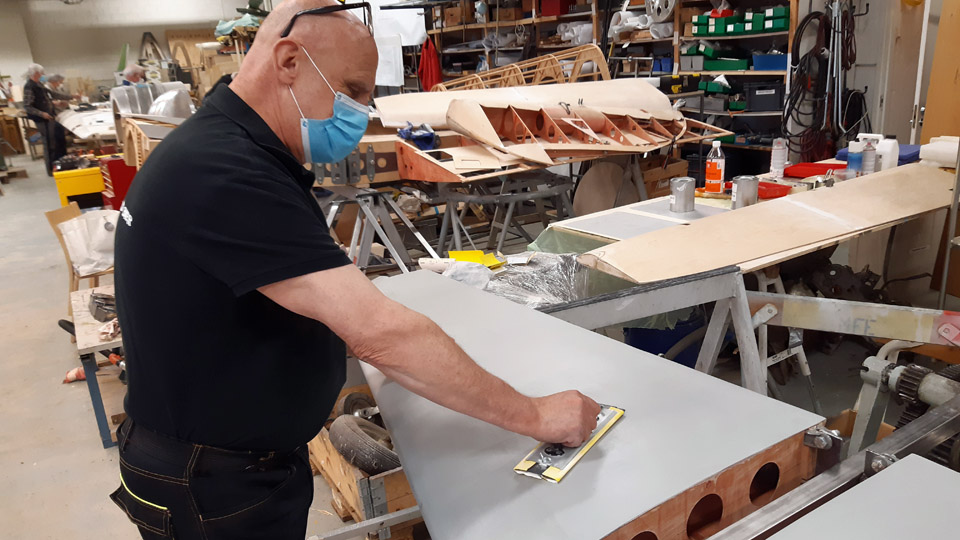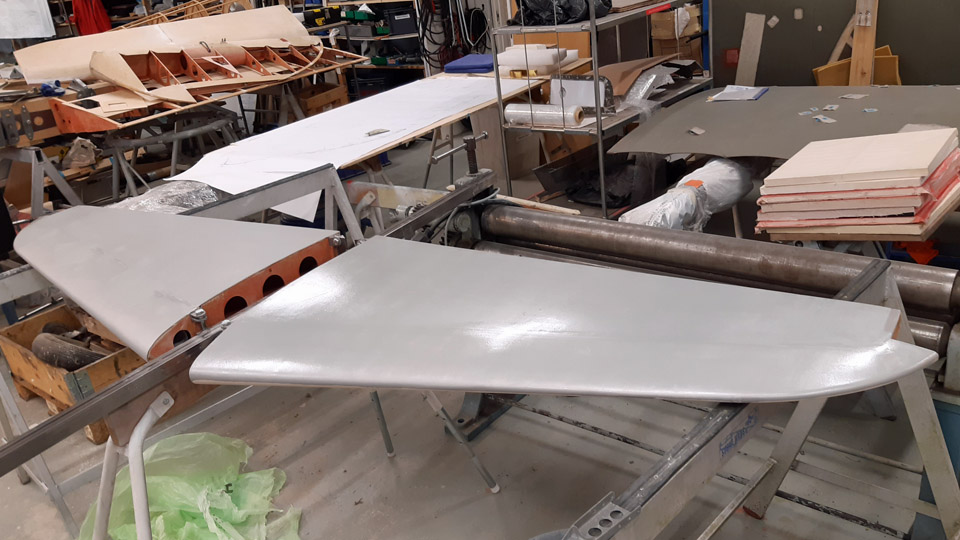Undercoat painting of MY-14?s horizontal stabilizerPerjantai 28.8.2020 - Tuesday Club member Before the painting work, the port and starboard halves of the VL Myrsky II’s (MY-14) horizontal stabilizer were fastened on an assembly jig, made of square steel tube. On the jig the stabilizer can be turned around as needed in the various phases of the surface treatment process.
The seams of the plywood covering on the horizontal stabilizer had been spackled and ground smooth before starting the undercoat painting work. The plywood surfaces were washed, using a water-Sinol-solution, containing 50% of water and 50% of Sinol. This is a normal procedure for removing grease from the surfaces before painting. After the wash, the surfaces were dried with a heat blower and sanded three times, with 240 abrasive paper.
Photo: Jouni Ripatti. The MY-14’s horizontal stabilizer will be painted in several phases. First an undercoat paint is spread on the plywood surface, and the actual paint is applied after this. There will be several layers of both paints. The undercoat paint and the actual surface paint are both alkyd paints, as were the original paints when the Myrsky fighters were being built in the 1940’s at the State Aircraft Factory (VL) in Tampere.
Right photo: Jouni Ripatti. The undercoat paint, which is used for the plywood surfaces of the MY-14 under restoration, is TEMALAC AB 70 alkyd paint which contains aluminium flakes. The shade of the paint is RAL 90006, white aluminium. The aluminium flakes will fill the grain structure on the plywood surface, which will make the plywood surface smooth and sealed when it is ground and honed.
Photo: Heikki Kaakinen. Now the upper and lower surfaces of the horizontal stabilizer have been painted once with the undercoat paint containing aluminium flakes. For the first layer the paint was made thinner, using Ruiskuohenne 1032, and the paintwork was done with a polyester roller (mini paint roller). The roller produced a very even layer. When the paint had dried, the surfaces were ground smooth for the second layer. The next undercoat paint layer will be done using paint, which is not thinned, and which is slightly darker in colour than the first layer. The darker shade will show clearly which areas have been painted for the second time and which haven’t. If a third layer of undercoat paint is needed, it will be darker than the second one.
An unexpected break in the painting work appeared, when the darker shade of TEMALAC AB 70 undercoat paint wasn’t available due to holidays. The Tuesday Club team will have to wait for the mixing and delivery of the darker paint before continuing the undercoat painting work on the horizontal stabilizer.
The MY-14’s horizontal stabilizer will eventually be painted according to the standard paint scheme of the Finnish Air Force in the 1940s: the upper surface will have a green and black pattern and the lower surface will be painted light blue. Photos (expect otherwise separately mentioned): Lassi Karivalo Translation: Erja Reinikainen |
|
Avainsanat: aviation history, restoration, VL Myrsky, MY-14 |







